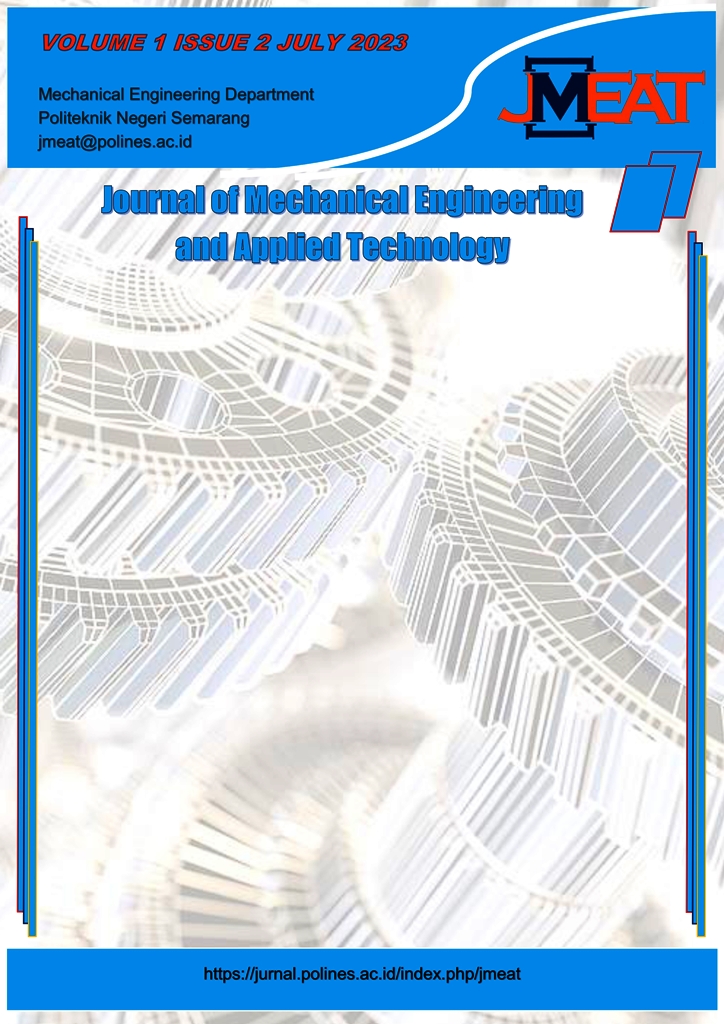Rancang Bangun Mesin Pengurai Gumpalan Tepung Tapioka Dengan Penggerak Motor Listrik 1 HP
DOI:
https://doi.org/10.32497/jmeat.v1i2.4876Keywords:
belt, electrical machine, flour machine, mixer, pulleyAbstract
Almost all tapioca flour manufacturers at the home S.M.E. level, particularly in the Sidomukti district of Pati, Central Java, manufacture tapioca flour only to the final stage as a lump of tapioca flour. The results of this S.M.E. cannot be directly marketed to consumers because it must go through a process again so that the flour is smooth, so S.M.E. will sell tapioca flour lumps in the factory to be processed into ready flour to be marketed, resulting in lower profits for S.M.E.s producing tapioca flour and because there is no machine to decompose tapioca flour clumps for household production scale. Machine for breaking lumps of tapioca flour, this 1-horsepower electric motor drive is designed to alleviate challenges in S.M.E.s. This machine has a 50kg/h capacity and uses a 1:5 rotation ratio transmission mechanism via pulleys and a belt. When the electric motor is turned on, pulley one on the motor will rotate and move pulley two on the shaft, which then drives the mixer (stirrer), which will break down the flour that is put through the hopper and immediately filtered by mess, which has a hole size of 0.5 mm, and flour will come out through the output hopper that is under the body. This machine is semi-automatically operated by pushing ON to turn on and OFF to turn off. This machine will perform as intendedReferences
Priyati, A., Abdullah, S.H., Muttalib, A.A., Hidayat, A.F., Apriandi, N., Baskara, Z.W., Metode pengepresan untuk meningkatkan kualitas industri pembuatan tahu di Kelurahan Kekalik Jaya Kota Mataram. Jurnal Ilmiah Abdi Mas TPB Unram. 2020 Januari; 2(01): p. 43-51.
Darma, D., Faisol, A., Dahlia, A.S., Rancang bangun dan uji kinerja mesin pemarut singkong tipe silinder untuk produksi tepung tapioka. Rekayasa, 2020; 13(03): p. 254-256.
Modeste, M., Adolphe, K.K.M., Boni, N., Edmond, K., Camile, K., Status of cassava (Manihot Esculento Crantz) in Cote d”™Ivoire: from production to consumption and evaluation of technology adoption. European Scientific Journal, 2018, 14(9): p. 285-299.
Hidayat, A.P., Santosa, S.H., Siskandar, R., Penentuan jumlah kebutuhan bahan baku berdasarkan distribusi barang ideal di IKM tepung tapioka kabupaten bogor. Jurnal INTECH, Juni 2022; 8(01): p. 23-28.
Yesi, D., Natalia, B., Kelayakan industri tepung tapioka di Desa Seri Tanjung Kecamatan Tanjung Batu Kabupaten Ogan Ilir Provinsi Sumatera Selatan. Publikasi Penelitian Terapan dan Kebijakan. 2018; 1(02): p. 69-76.
Fitriyah, A.T., Baharuddin, B., Ipteks bagi masyarakat kelompok usaha tapioka rakyat Desa Toddotoa Kecamatan Pallangga Kabupaten Gowa. Agrokompleks. 2015; 4(9): p. 21-32.
Shigley, J.E. dan Larry D. Mitchell. 1999. Perencanaan Teknik Mesin Jilid I. Jakarta: Erlangga.
Downloads
Published
Issue
Section
License
Authors who publish articles in this journal agree to the following terms:
The author owns the copyright and grants first publication rights to the Journal with work simultaneously licensed under a Creative Commons Attribution License which allows others to share the work with the work acknowledged and first published in this journal
Authors may enter into separate, additional contractual agreements for the non-exclusive distribution of the journal's published version of the work (for example, posting it to an institutional repository or publishing it in a book), with an acknowledgment of the first publication in this journal.
Authors are permitted and encouraged to upload their work online (for example, in an institutional repository or on an author's website) before and during the submission process, as this can lead to productive exchanges, as well as earlier citations and a larger number of citations of the published work. (See the impact of open Access).






